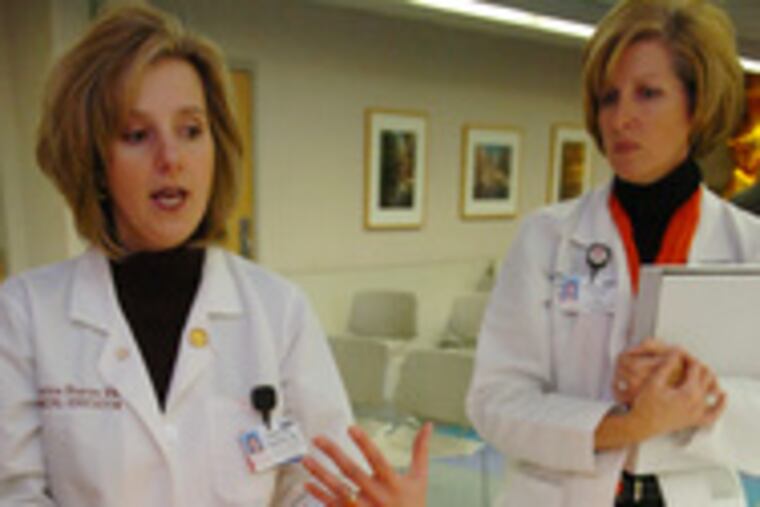Giving patients, and nurses, a lift
Devices help keep health-care workers healthy.

In 2004, Jean Lucas, a nurse, suffered a "life-altering" back injury while helping a 600-pound patient get into bed at Cooper University Hospital.
Lucas, then 60, ended up in the emergency room with a herniated disc after lifting the patient's leg. The injury forced her to retire.
"I just could not do 12-hour shifts three days a week anymore," she said earlier this week.
Lucas and other nurses have argued for years that injuries like hers could be avoided with devices that make it easier to lift or slide patients.
Increasingly, hospitals - and lawmakers - are listening.
Some hospitals are voluntarily investing in equipment they hope will keep nurses on the job and reduce workers-compensation claims. Others may soon have no choice.
New Jersey lawmakers expect to vote next week on a bill that would require hospitals and nursing homes to minimize manual lifting by employees. Seven states have already passed such laws, according to the American Nurses Association. No bill is pending in Pennsylvania.
"It's a big issue, and more and more we're using these adaptive devices," said Betsy Snook, executive director of the Pennsylvania State Nurses Association.
Nursing leaders say several trends are forcing hospitals to rethink how workers lift patients. For one, the nation's obesity epidemic has made patients a lot harder to move.
For another, the nursing shortage means that nurses themselves are older - nationally, the average age is 47 - and more susceptible to injury. Painful backs and shoulders lead to lost time and workers-comp claims. Because recruiting is difficult, hospitals and nursing homes want to keep nurses at the bedside as long as possible.
Richard Webster, vice president for musculoskeletal services at Thomas Jefferson University Hospital, said generational changes were also at work. Webster, who is a nurse, said younger nurses were, rightfully, less tolerant of job-related pain. "When I first started nursing, it was just sort of expected that, at the end of the day, you'd have a sore back," he said. "That was just part of the job."
Lucas, who was also a union leader at Cooper and still works occasional shifts there, was on hand this week as the Camden hospital announced a new program created in collaboration with the Health Professionals and Allied Employees, which represents 12,000 New Jersey nurses and health workers. Cooper has purchased 399 MaxiSlides: slippery, double-layered sheets that reduce friction when patients are repositioned in bed or moved to a stretcher.
The hospital also is testing more expensive devices that lift and transfer patients or help them sit and stand.
In Philadelphia, Jefferson is piloting lifting devices, and plans to decide which to buy early next year. Each of 35 new intensive-care-unit rooms being built next year will have ceiling-mounted lifts.
As part of its "Healthy Moves" program, the Hospital of the University of Pennsylvania bought overhead lifts this year for more than 250 of its rooms. Patients are suspended from the devices in slings. Penn also bought slider boards - boards surrounded by loose, slippery material. And physical therapists taught staff about safe lifting. Nurses were told to lock arms and work with their palms up while pulling patients from bed to gurney, said Jean Romano, manager of nursing products and operations.
Over the last three years, Christiana Care Health System in Delaware has installed more than 500 overhead lifts - each costing at least $5,000 - in three facilities. Even the morgue has them. For simpler moves, nurses use air-transfer mattresses, $2,000 devices that hover over the bed.
No one disputes that nursing is hard work. Nursing organizations cite a study that found that nurses lift 1.8 tons during a shift. Jeanne Otersen, the health-employee group's policy director, said injuries come from moving small patients as well as the growing numbers of large ones. A government agency found that most people couldn't lift more than 35 pounds safely, she said.
Because they are often moving weak patients from awkward angles, nurses face unusually high rates of back injury. A new survey of New Jersey nurses released this week by the health-employee group found that more than half were injured while moving patients in the last five years. Nurses were more worried about getting a back injury at work than about getting a drug-resistant infection.
"These nurses sometimes lift as much as truck drivers," said Sandra Jost, associate chief nursing officer at Penn. She decided that mechanical lifts "are the future" after attending a conference two years ago on the "mature" workforce. "We want to be able to use clinical nurses . . . for their mental prowess and not always to be exhausting them with the physical work," she said.
Proponents of the new assisted approach to patient handling say it is safer for both workers and patients.
Nursing and hospital leaders say the devices are gentler on delicate skin and make it easier for nurses to turn patients frequently. At Penn, the number of bed sores in the medical-intensive-care unit fell 60 percent after the overhead lifts were installed, the hospital said.
Although the equipment is costly - even the slider sheets cost $58 each - it can save money. Christiana Care estimates that its safe-patient-handling program reduced injury costs $4 million from 2002 to 2006. Lost work time has dropped 50 percent since 2002.